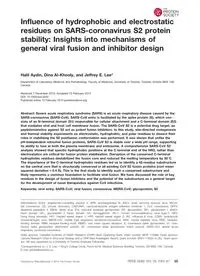
2014 Influence of hydrophobic and electrostatic residues on SARS-coronavirus S2 protein stability_ Insights into mechani PDF
Preview 2014 Influence of hydrophobic and electrostatic residues on SARS-coronavirus S2 protein stability_ Insights into mechani
Influence of hydrophobic and electrostatic residues on SARS-coronavirus S2 protein stability: Insights into mechanisms of general viral fusion and inhibitor design Halil Aydin, Dina Al-Khooly, and Jeffrey E. Lee* Department of Laboratory Medicine and Pathobiology, Faculty of Medicine, University of Toronto, Toronto, Ontario M5S 1A8, Canada Received 7 December 2013; Accepted 10 February 2014 DOI: 10.1002/pro.2442 Published online 12 February 2014 proteinscience.org Abstract: Severe acute respiratory syndrome (SARS) is an acute respiratory disease caused by the SARS-coronavirus (SARS-CoV). SARS-CoV entry is facilitated by the spike protein (S), which con- sists of an N-terminal domain (S1) responsible for cellular attachment and a C-terminal domain (S2) that mediates viral and host cell membrane fusion. The SARS-CoV S2 is a potential drug target, as peptidomimetics against S2 act as potent fusion inhibitors. In this study, site-directed mutagenesis and thermal stability experiments on electrostatic, hydrophobic, and polar residues to dissect their roles in stabilizing the S2 postfusion conformation was performed. It was shown that unlike the pH-independent retroviral fusion proteins, SARS-CoV S2 is stable over a wide pH range, supporting its ability to fuse at both the plasma membrane and endosome. A comprehensive SARS-CoV S2 analysis showed that specific hydrophobic positions at the C-terminal end of the HR2, rather than electrostatics are critical for fusion protein stabilization. Disruption of the conserved C-terminal hydrophobic residues destabilized the fusion core and reduced the melting temperature by 30�C. The importance of the C-terminal hydrophobic residues led us to identify a 42-residue substructure on the central core that is structurally conserved in all existing CoV S2 fusion proteins (root mean squared deviation 5 0.4 A˚ ). This is the first study to identify such a conserved substructure and likely represents a common foundation to facilitate viral fusion. We have discussed the role of key residues in the design of fusion inhibitors and the potential of the substructure as a general target for the development of novel therapeutics against CoV infections. Keywords: viral entry; SARS-CoV; viral fusion; coronavirus; MERS-CoV; glycoprotein; S2 Abbreviations: ACE2, angiotensin-converting enzyme 2; APN, aminopeptidase N; ASLV, avian sarcoma leucosis virus; BtCoV, bat coronavirus; CD, circular dichroism; CAECAM1, carcinoembryonic antigen adhesion molecule 1; CoV, coronavirus; DPP4, dipeptidyl peptidase 4; EBOV, ebola virus; Env, retroviral envelope glycoprotein; GP, glycoprotein; GP1, glycoprotein 1 attach- ment domain; GP2, glycoprotein 2 fusion domain; HA, hemagglutinin; HIV-1, human immunodeficiency virus type-1; HKU, Hong Kong university; HR1, Heptad repeat region 1; HR2, heptad repeat region 2; IAV, influenza A virus; LCMV, lymphocytic choriomeningitis virus; MERS-CoV, middle East respiratory syndrome-coronavirus; MHV, mouse hepatitis virus; RBD, receptor- binding domain; RBM, receptor-binding motif; RMSD, root mean square deviation; S, coronavirus spike glycoprotein; S1, coro- navirus spike glycoprotein attachment subunit; S2, coronavirus spike glycoprotein fusion subunit; SARS-CoV, severe acute respiratory syndrome-coronavirus. Grant sponsor: Canadian Institutes of Health Research (CIHR) Open Operating Grant; Grant number: MOP-115066, Grant sponsor: Canada Research Chair in Structural Virology and a CIHR New Investigator Award; Grant number: MSH-113554 to JEL. Grant spon- sor: HA was supported by a University of Toronto Graduate Fellowship. *Correspondence to: J. E. Lee, 1 King’s College Circle, Room 6316, Medical Sciences Building, Toronto, ON M5S 1A8, Canada. E-mail:
